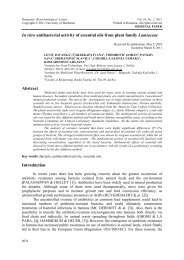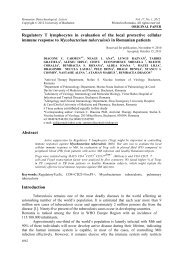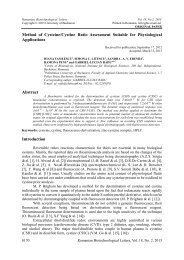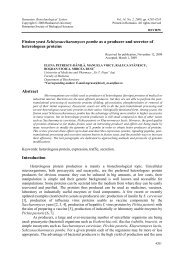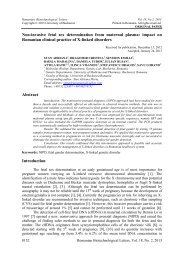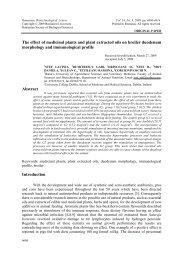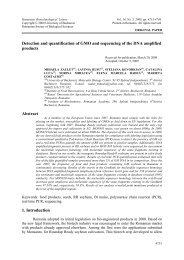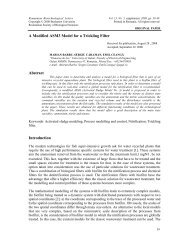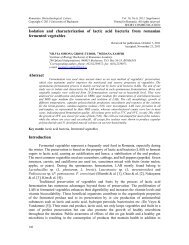Studies concerning the extraction of chlorophyll and ... - Rombio.eu
Studies concerning the extraction of chlorophyll and ... - Rombio.eu
Studies concerning the extraction of chlorophyll and ... - Rombio.eu
You also want an ePaper? Increase the reach of your titles
YUMPU automatically turns print PDFs into web optimized ePapers that Google loves.
Romanian Biotechnological Letters Vol. 17, No.5, 2012Copyright © 2012 University <strong>of</strong> BucharestPrinted in Romania. All rights reservedORIGINAL PAPER<strong>Studies</strong> <strong>concerning</strong> <strong>the</strong> <strong>extraction</strong> <strong>of</strong> <strong>chlorophyll</strong> <strong>and</strong> total carotenoids fromvegetablesReceived for publication, June 13, 2012Accepted, September 12, 2012AbstractMANUELA ADRIANA COSTACHE 1) , GHEORGHE CAMPEANU 2) ,GABRIELA NEATA 3)1)Faculty <strong>of</strong> Horticulture, USAMV, Bd. Marasti No. 59, Sect. 1, Bucharest, Romania;E-mail: manuela_bth@yahoo.com2 ) Faculty <strong>of</strong> Horticulture, USAMV, Bd. Marasti No. 59, Sect. 1, Bucharest, Romania;3 ) Faculty <strong>of</strong> Horticulture, USAMV, Bd. Marasti No. 59, Sect. 1, Bucharest, Romania;Corresponding author: E-mail: manuela_bth@yahoo.comThe main pigments found in vegetables are <strong>chlorophyll</strong> a, b <strong>and</strong> c. Chlorophyll a converts lightenergy into chemical energy through photosyn<strong>the</strong>sis process. The content <strong>of</strong> <strong>chlorophyll</strong> pigmentsvaries by species. The aim <strong>of</strong> <strong>the</strong> research was to determine simultaneously <strong>chlorophyll</strong> <strong>and</strong> carotenecontent from different vegetables by spectrophotometric method, testing three organic solvents to obtain<strong>the</strong> best <strong>extraction</strong> solution. 17 samples <strong>of</strong> cherry tomatoes, peppers <strong>and</strong> cucumbers, collected fromdifferent greenhouses located in sou<strong>the</strong>rn part <strong>of</strong> Romania were analyzed. The carotenoids <strong>and</strong><strong>chlorophyll</strong> pigments extracted in methanol, diethyl e<strong>the</strong>r <strong>and</strong> acetone, were determined based on <strong>the</strong>absorbance <strong>of</strong> three wavelengths: 470 nm, 645 nm-653 nm <strong>and</strong> 662 nm-666 nm. The results werecalculated according to <strong>the</strong> three "trichromatic equations" <strong>of</strong> Lichtentaler <strong>and</strong> Wellburn. The best<strong>extraction</strong> solvents for simultaneously determination <strong>of</strong> <strong>chlorophyll</strong> a <strong>and</strong> b <strong>and</strong> carotene weremethanol <strong>and</strong> acetone. For cherry tomatoes <strong>and</strong> tomatoes <strong>the</strong> best <strong>extraction</strong> solvent was methanol for<strong>chlorophyll</strong> a <strong>and</strong> acetone for carotene. For peppers <strong>the</strong> best <strong>extraction</strong> solvent was acetone <strong>and</strong> forcucumbers it was methanol. Variation coefficients were high, both between vegetable species <strong>and</strong>between tested varieties or hybrids.Keywords: a <strong>and</strong> b <strong>chlorophyll</strong>s, total carotenoids, <strong>extraction</strong>, vegetablesIntroductionThe presence <strong>of</strong> pigments in plant tissues gives color to vegetables <strong>and</strong> fruit, which isdifferent depending on variety <strong>and</strong> species. Pigments are substances with very differentchemical structure; <strong>the</strong>y are present in <strong>the</strong> form <strong>of</strong> porphyrin pigments, carotenoids,anthocyanins <strong>and</strong> flavones. The main porphyrin pigments found in vegetables are <strong>chlorophyll</strong> a,b <strong>and</strong> c. Chlorophyll a, <strong>the</strong> main pigment in plants, converts light energy into chemical energythrough photosyn<strong>the</strong>sis process. The content <strong>of</strong> <strong>chlorophyll</strong> pigments varies by species.Several studies <strong>concerning</strong> <strong>chlorophyll</strong> pigments determination using phytoplankton(ARAR [1, 2], BARLOW et al. [3], DON SANTOS et al. [7], FLANDER et al. [9], <strong>and</strong>HALLENGRAEFF [10]) <strong>and</strong> some species <strong>of</strong> algae (DERE et al. [8]) are reported.The change <strong>of</strong> <strong>chlorophyll</strong> pigment content from fruit <strong>and</strong> vegetables have a greatimportance for <strong>the</strong>ir color variation during <strong>the</strong> maturation phase. CIOFU [5] states that <strong>the</strong><strong>chlorophyll</strong> content <strong>of</strong> tomatoes during ripening period varied from 0.95 mg/100 g freshproduct to 0.12 mg/100 g fresh product after 7 day <strong>of</strong> storage (CȂMPEANU et al. [4],COSTACHE et al. [6]).Carotenoid pigments can be located in chromoplasts, contributing to <strong>the</strong> color <strong>of</strong>vegetables <strong>and</strong> fruits, or in chloroplasts, where, toge<strong>the</strong>r with <strong>chlorophyll</strong>s, are involved in <strong>the</strong>7702 Romanian Biotechnological Letters, Vol. 17, No. 5, 2012
<strong>Studies</strong> <strong>concerning</strong> <strong>the</strong> <strong>extraction</strong> <strong>of</strong> <strong>chlorophyll</strong> <strong>and</strong> total carotenoids from vegetablestwo phytosystems. Carotenoids group <strong>and</strong> <strong>the</strong>ir derivatives, include about 70 compounds thatare present in most vegetables <strong>and</strong> fruits. Among carotenoid pigments with 40 carbon atomsidentified in vegetables <strong>and</strong> fruits, β-carotene is <strong>the</strong> most popular <strong>and</strong> widespread. Inhorticultural products lycopene has been extensively identified. It is found mostly in tomato<strong>and</strong> o<strong>the</strong>r 70 plant species. Total carotenoid content <strong>of</strong> tomato pigments varies between 6.55mg/100 g <strong>and</strong> 12.0 mg/100 g fresh product. In pepper, <strong>the</strong> reported range is between 8.0 <strong>and</strong>25.0 mg/100 g fresh product (CIOFU [5]).The aim <strong>of</strong> <strong>the</strong> research was to determine <strong>the</strong> <strong>chlorophyll</strong> <strong>and</strong> carotene pigmentssimultaneously from different vegetables, using three organic solvents, in order to obtain <strong>the</strong>best <strong>extraction</strong> solution. Absorptive properties <strong>of</strong> <strong>the</strong> pigments were followed up inquantitative analysis using a spectrophotometric method. The literature presents two methodsto determine <strong>the</strong>se pigments - <strong>the</strong> trichromatic method <strong>and</strong> monochromatic method, <strong>the</strong> twomethods differing by <strong>the</strong> used wavelengths. It is known that <strong>chlorophyll</strong> pigments have broadabsorption b<strong>and</strong> from blue to red. Also <strong>the</strong> coextracted carotenoids have maximum absorptionin blue b<strong>and</strong> so that <strong>the</strong> chosen determination method is based on measuring <strong>the</strong> absorbance atthree wavelengths for each type <strong>of</strong> matrix <strong>and</strong> <strong>the</strong>n calculate <strong>chlorophyll</strong> <strong>and</strong> carotene using<strong>the</strong> three "trichromatic equations" <strong>of</strong> LICHTENTALER <strong>and</strong> WELLBURN [11, 12, 13].Materials <strong>and</strong> methodsThe research was conducted on 17 samples <strong>of</strong> several vegetable species collected fromdifferent greenhouses located in sou<strong>the</strong>rn part <strong>of</strong> Romania. Investigated species were cherrytomatoes, common tomatoes, peppers <strong>and</strong> cucumbers, in several varieties <strong>and</strong> hybrids existingin culture.Extraction <strong>of</strong> pigments was carried out in stoppered tubes. Vegetables samples wereprepared with a laboratory homogenizer using about 1 g fresh material. Three <strong>extraction</strong>solutions were used for each sample: 95% aqueous diethyl e<strong>the</strong>r solution (petrol<strong>eu</strong>m e<strong>the</strong>r),90% aqueous methanol solution <strong>and</strong> 100% acetone. The <strong>extraction</strong> ratio was 1:50.Homogenized mixture is separated by centrifugation at 3000 rpm, for 10 minutes.The analytical determination was performed with Helios α spectrophotometer at <strong>the</strong>following wavelengths: 645, 653, 662 <strong>and</strong> 664 nm, for <strong>chlorophyll</strong> a <strong>and</strong> b (according to each<strong>extraction</strong> solvent) <strong>and</strong> 470 nm for carotene.Equations used for calculation are presented below.Diethyl e<strong>the</strong>rChlorophyll a = 10.05 A662 -0.766 A644Chlorophyll b = 16.37 A664 – 3.140 A662Carotene = 1000 A470 – 1.280 Chl a – 56.7 Chl b/230MethanolChlorophyll a = 15.65 A666 – 7.340 A653Chlorophyll b = 27.05 A653 – 11.21 A666Carotene = 1000 A470 – 2.860 Chl a – 129.2 Chl b/245AcetoneChlorophyll a = 11.75 A662 – 2.350 A645Chlorophyll b = 18.61 A645 – 3.960 A662Carotene = 1000 A470 – 2.270 Chl a – 81.4 Chl b/227Romanian Biotechnological Letters, Vol. 17, No. 5, 2012 7703
<strong>Studies</strong> <strong>concerning</strong> <strong>the</strong> <strong>extraction</strong> <strong>of</strong> <strong>chlorophyll</strong> <strong>and</strong> total carotenoids from vegetablesMeasurements were performed in triplicates.Statistical interpretation <strong>of</strong> results was done using mean, st<strong>and</strong>ard deviation <strong>and</strong> coefficient <strong>of</strong> variation values (ANOVA programme).Results <strong>and</strong> discussionsAnalyses performed on several vegetables showed a large variety <strong>of</strong> <strong>chlorophyll</strong> a <strong>and</strong> b <strong>and</strong> also <strong>of</strong> carotene content.When performing diethyl e<strong>the</strong>r <strong>extraction</strong>, <strong>the</strong> content <strong>of</strong> <strong>chlorophyll</strong> a was small, difficult to detect, except <strong>the</strong> values obtained atcucumber determinations that had ranged from 7.21 mg/100 g fresh product to 33.76 mg/100 g fresh product (Table 1). The averaged was 23.14mg/100 g, <strong>the</strong> st<strong>and</strong>ard deviation was 10.31 <strong>and</strong> <strong>the</strong> coefficient <strong>of</strong> variation was 44.55% (Table 2).In <strong>the</strong> case <strong>of</strong> methanol <strong>extraction</strong>, <strong>the</strong> contents were higher, varying from 10.49 mg/100 g fresh product to 626.15 mg/100 g freshproduct. In <strong>the</strong> case <strong>of</strong> cherry tomatoes, <strong>chlorophyll</strong> a content varied between 10.49 mg/100 g to 28 mg/100 g fresh product <strong>and</strong> in commontomatoes, range values were between 10.49 mg/100 <strong>and</strong> 45.89 mg/100 g fresh product.In pepper, <strong>chlorophyll</strong> a results obtained by methanol <strong>extraction</strong> ranged from 45.89 mg/100 g <strong>and</strong> 127.52 mg/100 g fresh product <strong>and</strong> incucumber <strong>the</strong> values ranged from 354.06 mg/100 g to 626.15 mg/100 g fresh product.The acetone <strong>extraction</strong> <strong>of</strong> <strong>chlorophyll</strong> a, detected in tomatoes was low, ranging from 3.98 mg/100 g to 5.54 mg/100 g fresh product <strong>and</strong> inpepper <strong>the</strong> quantities <strong>of</strong> pigment had values between 181.06 mg/100 g <strong>and</strong> 416.07 mg/100 g fresh product. The highest values <strong>of</strong> <strong>chlorophyll</strong>extracted in acetone ranged between 259.89 mg/100 g <strong>and</strong> 466.27 mg/100 g fresh product.Table 1. Chlorophyll a <strong>and</strong> b <strong>and</strong> total carotenoids content, mg/100 g fresh productSpeciesCherrytomatoesCultivarDiethyl e<strong>the</strong>r 1:50 Mehtanol 1:50 Acetone 1:50Chlorophyll a Chlorophyll b Carotene Chlorophyll a Chlorophyll b Carotene Chlorophyll a Chlorophyll bCaroteneBelle F1 7.21 4.50 16.93 28.19 3.51 14.34 4.50 7.21 52.79Yellow pears 7.41 4.65 1.39 10.49 4.50 3.39 4.12 6.23 6.37Gold nugget 7.11 4.20 1.20 28.19 3.51 5.98 4.79 6.89 2.99Muscato F1 6.85 4.45 5.78 10.49 4.50 11.95 5.54 6.58 54.78Diamont F1 7.32 4.58 21.91 28.19 3.51 20.52 4.50 7.11 48.80Tomatoes Carabella F1 7.21 4.12 15.54 10.49 4.50 10.76 4.50 7.21 32.677704 Romanian Biotechnological Letters, Vol. 17, No. 5, 2012
MANUELA ADRIANA COSTACHE, GHEORGHE CAMPEANU, GABRIELA NEATAPeppersKaterina F1 16.06 4.01 3.98 19.34 4.01 10.76 4.65 6.53 34.26Ursula F1 7.11 4.50 11.95 19.34 4.01 7.77 3.98 6.89 37.65Winona F1 7.31 4.62 4.98 45.89 2.52 12.55 4.56 7.48 26.89Kaptur F1 7.11 4.15 1.59 45.89 2.52 4.78 48.02 105.86 11.95Fat papperBianca F1 7.21 4.50 1.20 47.87 63.45 2.59 181.06 357.56 35.46MaradonnaF1 7.02 4.32 8.96 127.52 59.00 42.83 416.07 714.78 74.70Bettina F1 7.21 4.50 2.39 540.93 412.31 28.09 390.80 201.82 27.49Asterix F1 16.06 4.01 1.00 478.64 359.84 25.10 440.80 272.28 21.31Cucumbers Alibi F1 33.76 3.02 4.98 626.15 397.38 33.86 466.27 255.23 25.10Fabrio 33.76 3.02 2.39 400.94 287.88 20.52 277.84 117.28 16.53Mirabell F1 24.91 3.51 2.19 354.06 254.90 18.13 259.89 175.3 13.94Table 2. Statistically interpretation <strong>of</strong> pigments content using different <strong>extraction</strong> solvents, mg/100 g fresh productDiethyl e<strong>the</strong>r Methanol AcetoneSpeciesCherrytomatoesCultivars Chlorophyll a Chlorophyll b Carotene Chlorophyll a Chlorophyll b Carotene Chlorophyll a Chlorophyll b CaroteneAverage 7.18 4.4761 9.44 21.11 3.9071 11.23 4.69 6.804 33.15Max 7.41 4.65 21.91 28.19 4.5 20.52 5.54 7.21 54.78Min 6.85 4.2 1.2 10.49 3.51 3.39 4.12 6.23 2.99St<strong>and</strong>arddeviation0.16 0.26 8.46 8.67 0.538 6.1 0.46 0.424 23.34Romanian Biotechnological Letters, Vol. 17, No. 5, 2012 7705
<strong>Studies</strong> <strong>concerning</strong> <strong>the</strong> <strong>extraction</strong> <strong>of</strong> <strong>chlorophyll</strong> <strong>and</strong> total carotenoids from vegetablesCv% 2.22 5.81 2.75 41.07 13.79 54.31 9.8 6.23 70.4TomatoesAverage 9.422 4.311 9.11 23.765 3.758 10.46 4.42 7.02 32.87Max 16.06 4.62 15.54 45.89 4.5 12.55 4.65 7.48 37.65Min 7.11 4.006 3.98 10.49 2.52 7.77 3.98 6.53 26.89St<strong>and</strong>arddeviation3.83 0.27 4.82 13.3 0.734 1.7 0.28 0.479 3.87Cv% 40.65 6.26 52.9 55.97 19.57 16.25 6.33 6.82 11.77PeppersAverage 7.113 4.323 3.92 73.76 41.658 16.73 215.05 392.73 40.7Max 7.21 4.5 8.96 127.52 59 42.83 416.74 714.78 74.7Min 7.02 4.15 1.2 45.89 2.52 2.59 48.02 105.86 11.95St<strong>and</strong>arddeviation0.218 0.21 3.57 38.01 27.73 18.46 4.81 7.93 25.88Cv% 3.06 4.86 91.07 51.53 66.57 90.27 22.39 20.23 91.27CucumbersAverage 23.14 3.61 2.59 480.144 342.461 25.14 367.11 204.38 20.88Max 23.76 4.5 4.98 540.93 412.31 33.86 466.26 272.28 27.49Min 7.21 3.07 1 354.89 254.89 18.13 259.89 117.28 13.94St<strong>and</strong>arddeviation10.31 0.574 1.3 97.85 61.39 4.16 84.2 57.3 5.05Cv% 44.55 15.9 50.19 52.15 47.95 16.55 46.3 48.56 24.187706 Romanian Biotechnological Letters, Vol. 17, No. 5, 2012
MANUELA ADRIANA COSTACHE, GHEORGHE CAMPEANU, GABRIELA NEATAComparing <strong>the</strong> values <strong>of</strong> <strong>the</strong> three <strong>extraction</strong> variants <strong>of</strong> <strong>chlorophyll</strong> a, best resultswere obtained with methanol <strong>and</strong> acetone.Chlorophyll b <strong>extraction</strong> with diethyl e<strong>the</strong>r registered low results obtained in all <strong>the</strong>tested vegetables, being close to <strong>the</strong> limit <strong>of</strong> detection <strong>of</strong> <strong>the</strong> spectrophotometer.Extraction with methanol resulted in high values <strong>of</strong> <strong>chlorophyll</strong> b in peppers <strong>and</strong>cucumbers; <strong>the</strong> peppers values ranged between 2.52 mg/100 g <strong>and</strong> 63.45 mg/100 g freshproduct <strong>and</strong> <strong>the</strong> cucumbers values ranged from 254.90 mg/100 g to 412.31 g/100 g freshproduct.When using acetone, <strong>the</strong> <strong>extraction</strong> <strong>of</strong> <strong>chlorophyll</strong> b is decreased in tomatoes, near <strong>the</strong>limit <strong>of</strong> detection <strong>of</strong> <strong>the</strong> device <strong>and</strong> high in peppers <strong>and</strong> cucumbers.Results <strong>of</strong> <strong>the</strong> <strong>extraction</strong> <strong>of</strong> <strong>chlorophyll</strong> b showed that acetone solvent determined <strong>the</strong>best results followed by <strong>extraction</strong> with methanol.Statistical interpretation <strong>of</strong> <strong>the</strong> results for <strong>chlorophyll</strong> a determination showed that <strong>the</strong>best results were obtained from <strong>extraction</strong> with methanol where <strong>the</strong> coefficient <strong>of</strong> variationwas 41.07% in cherry tomatoes, 55.97% in common tomatoes, 51.53% in peppers <strong>and</strong>52.15% in cucumbers (Table 2).In <strong>the</strong> case <strong>of</strong> <strong>chlorophyll</strong> b <strong>extraction</strong>, <strong>the</strong> best coefficients <strong>of</strong> variation were obtainedusing <strong>extraction</strong> with methanol respectively 13.79% in cherry tomatoes 19.57% in commontomatoes, 66.57% in peppers <strong>and</strong> 47.95% in cucumbers (Table 2).Diethyl e<strong>the</strong>r solvent determined a different <strong>extraction</strong> <strong>of</strong> carotene, so at tomatoes <strong>the</strong>values ranged between 1.20 mg/100 g <strong>and</strong> 21.91 mg/100 g in fresh product, while at peppers<strong>and</strong> cucumbers low <strong>extraction</strong> values were obtained (Table 1).Methanol <strong>extraction</strong> determined higher levels <strong>of</strong> carotene pigment in tomatoes,varying between 3.39 mg/100 g <strong>and</strong> 20.52 mg/100 g in fresh product, in pepper <strong>the</strong>concentrations <strong>of</strong> carotene were between 2.59 mg/100 g <strong>and</strong> 42.83 mg/100 g in fresh product,<strong>and</strong> in cucumbers <strong>the</strong> concentrations obtained ranged from 18.13 mg/100 g <strong>and</strong> 33.86 mg/100g fresh product.In <strong>the</strong> third extracting solution – acetone, <strong>the</strong> obtained carotene values were higher,thus in tomatoes were between 2.99 mg/100 g <strong>and</strong> 54.78 mg/100 g fresh product, in peppersbetween 11.95 mg/100 g <strong>and</strong> 74.70 mg/100 g fresh product, <strong>and</strong> in cucumbers <strong>the</strong>concentrations ranged from 13.94 mg/100 g fresh product <strong>and</strong> 27.49 mg/100 g fresh product(Table 1).Comparing <strong>the</strong> results <strong>of</strong> <strong>the</strong> three <strong>extraction</strong>s <strong>of</strong> carotene, acetone <strong>extraction</strong>determined <strong>the</strong> best results in all analyzed vegetables: tomatoes, peppers <strong>and</strong> cucumbers.Statistical interpretation <strong>of</strong> results <strong>of</strong> carotene showed that acetone <strong>extraction</strong> resultedin <strong>the</strong> best variation coefficient respectively 70.4% at cherry tomatoes, 11.77% at commontomatoes, 91.27% at peppers <strong>and</strong> 24.18% at cucumbers. Methanol <strong>extraction</strong> also showedcoefficient <strong>of</strong> variation <strong>of</strong> <strong>the</strong> results slightly lower than for acetone <strong>extraction</strong>, respectively54.31% for cherry tomatoes, 16.25% for common tomatoes, 90.27% for peppers <strong>and</strong> 16.55%for cucumbers (Table 2).ConclusionsThe best <strong>extraction</strong> solvents for simultaneously determination <strong>of</strong> <strong>chlorophyll</strong> a <strong>and</strong> b<strong>and</strong> carotene were methanol <strong>and</strong> acetone. For cherry tomatoes <strong>and</strong> tomatoes <strong>the</strong> best<strong>extraction</strong> solvent was methanol for <strong>chlorophyll</strong> a <strong>and</strong> acetone for carotene. For peppers <strong>the</strong>best <strong>extraction</strong> solvent was acetone <strong>and</strong> for cucumbers is methanol;Variation coefficients were high, both between vegetable species <strong>and</strong> between testedvarieties or hybrids.Romanian Biotechnological Letters, Vol. 17, No. 5, 2012 7707
<strong>Studies</strong> <strong>concerning</strong> <strong>the</strong> <strong>extraction</strong> <strong>of</strong> <strong>chlorophyll</strong> <strong>and</strong> total carotenoids from vegetablesDetermination <strong>of</strong> <strong>the</strong> three pigments from different vegetables can be provided withspectrophotometric method using methanol as extractant. Beacause <strong>the</strong> methanol is toxic,<strong>extraction</strong> with acetone is preferred, providing reliable results that must be corrected with asuitable coefficient according to <strong>the</strong> vegetable species.AknowledgementThese researches were supported by <strong>the</strong> POSDRU/88/1.5/S/52614 Programme.References1. E.J. ARAR, Determination <strong>of</strong> Chlorophyll a, b, c1 <strong>and</strong> c2, <strong>and</strong> Pheophytin a in marine <strong>and</strong> freshwaterphytoplankton by Spectrophotometry, EPA, (1997).2. E.J. ARAR, Determination <strong>of</strong> Chlorophyll a,b, c1 <strong>and</strong> c2, <strong>and</strong> Pheophytin a in marine <strong>and</strong> freshwaterphytoplankton by High Performance Liquid Cromatography, EPA, Cincinnati (1997).3. R.G. BARLOW, R.F.C. MANTOURA, D.G.CUMMINGS, Phytoplankton pigments distribution <strong>and</strong>associated fluxes in <strong>the</strong> Bellinghauser Sea during <strong>the</strong> austral spring 1992, J. Mar. Sys. 17:97-113 (1998)4. GH. CÂMPEANU, , M.A. COSTACHE, , G. NEAŢĂ , Research on <strong>the</strong> methodology <strong>of</strong> <strong>chlorophyll</strong> <strong>and</strong>carotene content <strong>extraction</strong> in cucumbers <strong>and</strong> peppers grown in <strong>the</strong> south <strong>of</strong> Romania area, Annals’ OfThe University Of Craiova, XVI (LII), pp. 74-82 (2011).5. R. CIOFU, N. STAN, V. POPESCU, P. CHILOM, S. APAHIDEAN, A.HORGOŞ, V.BERAR, K.F.LAUER, N. ATANASIU, Tratat de legumicultură, Ed. Ceres, București, (2003).6. M. A. COSTACHE, GH. CÂMPEANU, G. NEAŢĂ, Research on <strong>the</strong> methodology <strong>of</strong> <strong>extraction</strong> <strong>of</strong><strong>chlorophyll</strong> <strong>and</strong> carotene content <strong>of</strong> tomatoes grown in <strong>the</strong> south <strong>of</strong> Romania area, Scientifical PapersU.S.A.M.V. Bucharest, seria B, LV, pp. 069-073 (2011).7. DON SANTOS, A.C.A., CALIJURI, M.C., MORAES, E.M., ADORNO, M.A.T., FLACO, P.B.,CARVALHO, D.P., DEBERDT, G.L.B. & BENASSI, S.F., Comparison <strong>of</strong> three methods for Chlorophylldetermination: Spectrophotometry <strong>and</strong> Fluorimetry in samples containing pigment mixtures <strong>and</strong>spectrophometry in samples with separate pigments through High Performance Liquid Chromatography,Acta Limnol. Bras., 15(3):7-18 (2003).8. Ş.DERE, T.GUNES,R. SIVACI, , Spectrophotometric Determination <strong>of</strong> Chlorophyll - A, B <strong>and</strong> TotalCarotenoid Contents <strong>of</strong> Some Algae Species Using Different Solvents, Tr. J. <strong>of</strong> Botany, 22, pp. 13-17(1998).9. P.V. FLANDER, T.SENKA, M. ALENKA, A. MARIJAN, Effect <strong>of</strong> mucilage event on <strong>the</strong> distribution <strong>of</strong>summer phytoplankton as reflected by phytoplankton pigments, Per. Biol.,102:169-177 (2000).10. G.M. HALLENGRAEFF, Seasonal study <strong>of</strong> pkytoplankton pigments <strong>and</strong> species at a coastal station <strong>of</strong>fSidney: Importance <strong>of</strong> diatoms <strong>and</strong> <strong>the</strong> nanoplankton, Mar. Biol., 61:107-118 (1981).11. H.K. LICHTENTHALER, A.R. WELLBURN, Determination <strong>of</strong> Total Carotenoids <strong>and</strong> Chlorophylls A<strong>and</strong> B <strong>of</strong> Leaf in Different Solvents, Biol. Soc. Trans., 11, pp. 591-592 (1985).12. D.P. SATORY, Extraction <strong>of</strong> Chlorophyll A from Freshwater Phytoplankton for SpectrophotometricAnalysis, M. Sc. Hesis. Univ. Orange free state, Bloemfontein, Republic <strong>of</strong> S. Africa (1982).13. A.R. WELLBURN, The Spectral Determination <strong>of</strong> Chlorophylls A <strong>and</strong> B, as well as Total Carotenoids,Using Various Solvents with Spectrophotometers <strong>of</strong> Different Resolution, J. Plant Phys. 144, 307-313(1994).7708 Romanian Biotechnological Letters, Vol. 17, No. 5, 2012



